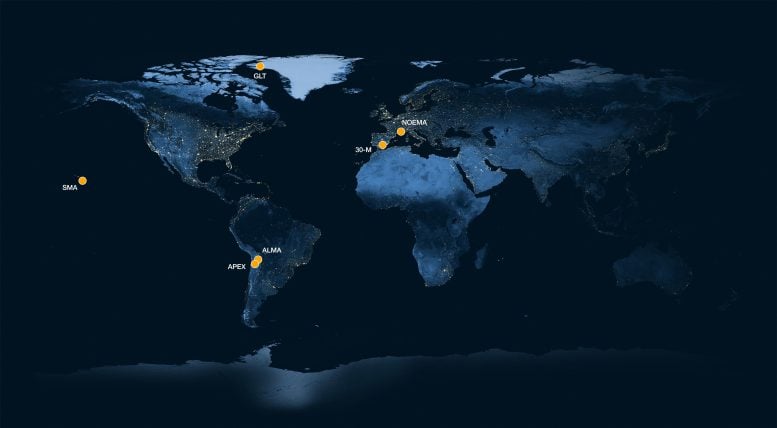The Event Horizon Telescope (EHT) Collaboration has enhanced its observational capabilities, achieving unprecedented resolutions by detecting light at a 345 GHz frequency.
This breakthrough allows for detailed imaging of black holes, promising images 50% more detailed than previous ones and the potential to view more black holes than ever before.
Breakthrough in Black Hole Imaging
The Event Horizon Telescope (EHT) Collaboration has conducted test observations, using the Atacama Large Millimeter/submillimeter Array (
In this episode of Chasing Starlight, in 2019, and of Sgr A*, the black hole at the heart of our “With the EHT, we saw the first images of black holes using the 1.3-mm wavelength observations, but the bright ring we saw, formed by light bending in the black hole’s gravity, still looked blurry because we were at the absolute limits of how sharp we could make the images,” said the study’s co-lead Alexander Raymond, previously a postdoctoral scholar at the Center for Astrophysics | Harvard & Smithsonian (
Credit: Christian M. Fromm, Julius-Maximilian University, Würzburg
This animation video shows the locations of the radio observatories which participated in a pilot experiment conducted by the Event Horizon Telescope (EHT) Collaboration that obtained the highest-resolution observations from the ground. Credit: ESO/M. Kornmesser
Exciting Prospects for Future Black Hole Research
This technical test has opened up a new window to study black holes. With the full array, the EHT could see details as small as 13 microarcseconds, equivalent to seeing a bottle cap on the Moon from Earth. This means that, at 0.87 mm, they will be able to get images with a resolution about 50% higher than that of previously released M87* and SgrA*[3] 1.3-mm images. In addition, there’s potential to observe more distant, smaller and fainter black holes than the two the Collaboration has imaged thus far.
EHT Founding Director Sheperd “Shep” Doeleman, an astrophysicist at the CfA and study co-lead, says: “Looking at changes in the surrounding gas at different wavelengths will help us solve the mystery of how black holes attract and accrete matter, and how they can launch powerful jets that stream over galactic distances.”

The facilities that participated were: the Atacama Large Millimeter/submillimeter Array (ALMA) and the Atacama Pathfinder EXperiment (APEX), in Chile, the IRAM 30-meter (30-M) telescope in Spain and the NOrthern Extended Millimeter Array (NOEMA) in France, as well as the Greenland Telescope (GLT) and the Submillimeter Array (SMA) in Hawaiʻi. ESO is a partner in ALMA and co-hosts and co-operates APEX.
Credit: ESO/M. Kornmesser
Implications for Astrophysical Studies
This is the first time that the VLBI technique has been successfully used at the 0.87 mm wavelength. While the ability to observe the night sky at 0.87 mm existed before the new detections, using the VLBI technique at this wavelength has always presented challenges that took time and technological advances to overcome. For example, water vapor in the atmosphere absorbs waves at 0.87 mm much more than it does at 1.3 mm, making it more difficult for radio telescopes to receive signals from black holes at the shorter wavelength. Combined with increasingly pronounced atmospheric turbulence and noise buildup at shorter wavelengths, and an inability to control global weather conditions during atmospherically sensitive observations, progress to shorter wavelengths for VLBI — especially those that cross the barrier into the submillimetre regime — has been slow. But with these new detections, that’s all changed.
“These VLBI signal detections at 0.87 mm are groundbreaking since they open a new observing window for the study of supermassive black holes”, states Thomas Krichbaum, a co-author of the study from the Max Planck Institute for Radio Astronomy in Germany, an institution that operates the APEX telescope together with ESO. He adds: “In the future, the combination of the IRAM telescopes in Spain (IRAM-30m) and France (NOEMA) with ALMA and APEX will enable imaging of even smaller and fainter emission than has been possible thus far at two wavelengths, 1.3 mm and 0.87 mm, simultaneously.”
Notes
- There have been astronomical observations with higher resolution, but these were obtained by combining signals from telescopes on the ground with a telescope in space: https://www.mpifr-bonn.mpg.de/pressreleases/2022/2. The new observations released today are the highest-resolution ones ever obtained using only ground-based telescopes.
- To test their observations, the EHT Collaboration pointed the antennas to very distant ‘active’ galaxies, which are powered by supermassive black holes at their cores and are very bright. These types of sources help to calibrate the observations before pointing the EHT to fainter sources, like nearby black holes.
- The GRAVITY instrument on ESO’s




















Discussion about this post